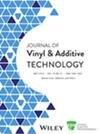A new strategy to fabricate polyvinyl chloride with antistatic and water extraction resistance by modification of nitrile rubber
Abstract
Antistatic plasticizer can significantly enhance the antistatic properties of polyvinyl chloride (PVC), mitigating the potential hazards associated with static electricity (such as damage to electronic components, fire, explosion, etc.). However, the poor water resistance of the plasticizer dibutoxyethoxyethyl adipate (DBEEA) will limit the application performance of materials. In this work, powdered nitrile rubber (PNBR) was ingeniously used to improve the water extraction resistance of DBEEA in PVC. With 30 wt% PNBR added in plasticized PVC, the mass loss rate can reduce 4.96 wt% than plasticized PVC film. Meanwhile, the volume and surface resistivities of PVC/PNBR exposed to air are in the order of 106 Ω·m and 109 Ω, which meets the antistatic requirements of the relevant fields (such as electronics, healthcare, and chemical industry). After water immersion, both the volume and surface resistivity of PVC containing 30 wt% PNBR remain 107 and 1011 Ω, respectively. Furthermore, PVC/PNBR exhibits excellent low-temperature resistance (−28 °C), thermal stability and elasticity, which will broaden the application areas of antistatic plasticized PVC.
Highlights
- The plasticized PVC/PNBR with antistatic property is prepared.
- PNBR has good adsorption to DBEEA.
- PVC/PNBR exhibits superior low-temperature resistance and thermal stability.





 求助内容:
求助内容: 应助结果提醒方式:
应助结果提醒方式:


